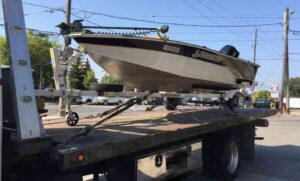In an era where vehicle reliability is paramount, a dead car battery remains one of the most common reasons for roadside assistance calls. While traditional jumper cables require a second vehicle, the advent of portable jump starters, particularly those powered by Lithium Jump Pack Battery technology, has revolutionized how drivers handle such emergencies. These compact, powerful devices have become indispensable tools for many in Ontario, including our valued clients in Aurora.
However, like all batteries, the Lithium Jump Pack Battery inside your device has a finite lifespan. When it starts to lose its charge quickly, struggles to jump-start, or exhibits signs of degradation, the question arises: should you replace the entire unit, or can you perform a Lithium Jump Pack Battery replacement yourself?
This comprehensive article will explore the lifespan and signs of wear in Lithium Jump Pack Battery units, delve into the complex safety considerations of attempting a DIY battery replacement, and ultimately explain why, for most users, investing in a new unit or calling professional roadside assistance like Pars Towing remains the safest and most reliable solution.
- Learn More >>>>Car Battery Booster
Lithium Jump Pack Battery Replacement: A Deep Dive into Lifespan, Safety, and When to Call Pars Towing
1. The Rise of the Lithium Jump Pack Battery: Power in Your Palm
Lithium Jump Pack Battery technology has rapidly surpassed traditional lead-acid jump starters due to several key advantages:
- Compact Size and Lightweight: Lithium-ion batteries offer incredible energy density, allowing jump packs to be small enough to fit in a glove compartment or under a seat.
- High Cranking Power: Despite their size, they can deliver a powerful burst of current needed to start a dead car battery.
- Longer Shelf Life: They typically hold a charge for much longer periods (e.g., 6-12 months) compared to lead-acid counterparts, which often require charging every 1-3 months.
- Versatility: Many Lithium Jump Pack Battery units include USB ports for charging phones and other devices, flashlights, and even air compressors, making them multi-functional emergency tools.
- Faster Charging: Lithium batteries generally charge much quicker than lead-acid batteries.
These benefits have made the Lithium Jump Pack Battery a go-to device for preparedness, not just for personal vehicles but also for commercial fleets and towing professionals like Pars Towing.
- Learn More >>>>Making Car Jump Starter PowerBank
2. Understanding the Lifespan of a Lithium Jump Pack Battery
While highly efficient, a Lithium Jump Pack Battery isn’t immortal. Its lifespan is typically measured in:
- Charge Cycles: Most lithium-ion batteries are rated for 300 to 500 full charge-discharge cycles before their capacity begins to significantly degrade (e.g., to 80% of original capacity). Some high-quality units, especially those using LiFePO4 (Lithium Iron Phosphate) chemistry, may offer 1000+ cycles.
- Calendar Age: Even with minimal use, lithium-ion batteries degrade over time. The average lifespan for a Lithium Jump Pack Battery is usually 3 to 5 years, though some premium brands might stretch this to 5-7 years with optimal care.
Several factors can impact this lifespan:
- Charging Habits: Overcharging (though most modern packs have overcharge protection) and consistently letting the battery drain completely before recharging can shorten its life. Regular “maintenance charges” (e.g., every 3-6 months) are crucial.
- Storage Temperature: Extreme temperatures are a lithium battery’s worst enemy. Storing a Lithium Jump Pack Battery in a scorching hot car in the summer or a freezing cold garage in an Ontario winter can significantly accelerate degradation and reduce performance. Room temperature is ideal for storage.
- Usage Frequency: While designed for use, very frequent and deep discharges will naturally consume charge cycles faster.
- Battery Quality: The quality of the internal cells and the Battery Management System (BMS) plays a huge role. Cheaper units often use lower-grade cells that degrade faster.
3. Signs Your Lithium Jump Pack Battery Needs Replacement
Recognizing when your Lithium Jump Pack Battery is failing is key to avoiding being stranded. Look for these common indicators:
- Reduced Performance: The most obvious sign. If your jump pack used to effortlessly start your vehicle but now struggles, takes multiple attempts, or simply doesn’t have the “oomph” it once did, its capacity has degraded.
- Doesn’t Hold a Charge: You charge it fully, but it quickly drops to 50% or less even when not used, or it won’t hold a charge for more than a few days/weeks.
- Takes Too Long to Charge: While generally fast-charging, an old battery might take an unusually long time to reach full capacity.
- Physical Swelling/Bloating: This is a critical safety warning. If the casing of your Lithium Jump Pack Battery appears swollen, bulging, or warped, it indicates internal cell failure (often gas buildup) and poses a serious fire hazard. Immediately discontinue use and dispose of it safely.
- Overheating During Charging/Use: Excessive heat during charging or discharge (beyond normal warmth) can signal internal problems.
- Indicator Lights Malfunctioning: If the charge indicator lights are erratic or don’t seem to reflect the actual charge level accurately.
If you observe any of these signs, especially swelling or overheating, it’s time to stop using your Lithium Jump Pack Battery.
4. The Perilous Path of DIY Lithium Jump Pack Battery Replacement
The idea of simply swapping out the internal battery in your Lithium Jump Pack Battery might seem appealing for cost savings or environmental reasons. However, this is a highly complex and dangerous undertaking that is strongly discouraged for the vast majority of consumers.
4.1. The Dangers of Handling Lithium-Ion Batteries
Lithium-ion batteries are incredibly energy-dense, which is why they are so powerful, but this also means they store immense energy that can be catastrophically released if mishandled.
- Thermal Runaway & Fire Hazard: This is the most significant risk. If a lithium-ion cell is punctured, overcharged, short-circuited, overheated, or physically damaged during replacement, it can enter a state of “thermal runaway.” This is an uncontrolled self-heating process that can lead to:
- Rapid Ignition: The battery can quickly catch fire, often with explosive force.
- High Temperatures: Temperatures can reach thousands of degrees Celsius.
- Toxic Fumes: Burning lithium-ion batteries release highly toxic and irritating fumes.
- Difficult to Extinguish: Lithium fires are extremely difficult to put out, often requiring specialized fire suppressants (Class D extinguishers for lithium metal fires, or copious amounts of water for lithium-ion fires to cool them).
- Electrical Shock: Even a seemingly dead Lithium Jump Pack Battery can still hold residual charge. Improper handling of terminals or internal wiring can lead to severe electrical shock.
- Short Circuits: Accidental contact between positive and negative terminals with a metal tool can cause a rapid discharge, leading to sparks, extreme heat, and fire.
- Physical Injury: Sharp tools used for prying open the casing can cause lacerations.
- Learn More >>>>Quick Jump Start Service
4.2. Technical Challenges and Specifics of Replacement
Beyond the inherent dangers, performing a Lithium Jump Pack Battery replacement presents numerous technical hurdles:
- Proprietary Design: Most consumer Lithium Jump Pack Battery units are not designed for user-serviceability. They are often glued, ultrasonically welded, or use proprietary screws, making it difficult to open them without damaging the casing or internal components.
- Integrated Battery Management System (BMS): A crucial component of any Lithium Jump Pack Battery is its BMS. This circuit board monitors cell voltage, temperature, current, and balances the cells during charging and discharging. It’s often integrated into the battery pack itself or precisely calibrated to the specific battery. Replacing the battery without understanding or correctly re-interfacing with the BMS can render the unit useless or dangerous.
- Specific Cell Types: Jump packs often use specific high-drain lithium-ion cells (e.g., LiFePO4 or specific 18650/21700 cells) that are not readily available or easily identifiable for a consumer to purchase correctly. Matching voltage, capacity, and current discharge ratings is crucial.
- Complex Wiring and Soldering: Replacing the internal battery often requires intricate soldering, correct wiring polarity, and potentially re-assembling a multi-cell pack. Improper soldering can create weak connections or short circuits.
- No Official Support: Manufacturers typically do not provide replacement batteries or instructions for DIY replacement, voiding any remaining warranty.
Given these formidable challenges and risks, DIY Lithium Jump Pack Battery replacement is highly ill-advised for anyone without extensive experience in electronics, lithium battery pack assembly, and specialized safety equipment.

5. What to Do When Your Lithium Jump Pack Battery Fails
When your Lithium Jump Pack Battery starts showing signs of failure, there are two primary responsible courses of action:
5.1. Option 1: Dispose and Replace (The Recommended Path)
- Safe Disposal: Do NOT just throw the old Lithium Jump Pack Battery in your household trash. Lithium-ion batteries are considered hazardous waste. Contact your local municipal waste management facility in Aurora or Ontario for proper recycling and disposal guidelines. Many electronics stores or battery retailers also offer battery recycling programs.
- Invest in a New Unit: For most consumers, the safest and most reliable approach is to purchase a new Lithium Jump Pack Battery from a reputable brand. Prices have become very competitive, and new units come with fresh warranties, guaranteed performance, and intact safety circuitry.
- Cost vs. Risk: The cost of a new jump pack (often $100-$300 CAD) is negligible compared to the potential cost of fire damage, medical bills from injury, or vehicle electrical repair from a botched DIY replacement.
- Technological Advancements: Newer models often feature improved safety features, higher capacity, and faster charging capabilities.
- Learn More >>>>Toyota Service Jump Start a Dead Battery in Seconds
5.2. Option 2: Rely on Professional Roadside Assistance (Pars Towing)
Even if you own a Lithium Jump Pack Battery, having a reliable roadside assistance provider like Pars Towing on speed dial is essential for those times when:
- Your Jump Pack Fails: The ultimate irony – your jump pack is dead when you need it most.
- It’s Too Cold: Extreme Ontario winter temperatures can severely reduce the performance of even a fully charged lithium jump pack.
- The Problem Isn’t Just the Battery: Sometimes, a “dead battery” is a symptom of a larger issue (e.g., faulty alternator, starter motor problem, severe parasitic drain, or complex EV issue). Pars Towing can diagnose the situation and provide the appropriate solution, whether it’s a professional jump-start or a tow.
- You’re Unsure or Uncomfortable: If you’re physically unable, or simply uncomfortable connecting jumper cables, especially with modern vehicles and their sensitive electronics.
- Safety is a Concern: You’re stranded in an unsafe location (e.g., busy highway, unlit road) and prefer to wait in your vehicle for professional help.
6. Pars Towing: Your Go-To for Battery Boosts and Beyond in Aurora & Ontario
At Pars Towing, we are fully equipped and trained to handle battery-related issues for all types of vehicles in Aurora and throughout Ontario.
- Professional Battery Boost Service: Our technicians carry robust, professional-grade jump-starting equipment, often including powerful lithium-ion jump packs themselves, capable of safely boosting even large trucks or deeply discharged batteries. We know the correct procedures for connecting to modern vehicles (including electric vehicles) to prevent damage to sensitive electronics.
- Diagnostic Capabilities: Beyond just a boost, our team can often provide a basic assessment to help determine if your car battery is truly dead or if there’s an underlying issue requiring further attention.
- Towing to Your Destination: If a jump-start doesn’t work, or if the underlying problem makes driving unsafe, we can immediately transition to towing your vehicle to a reputable service centre, your home, or a trusted mechanic in Aurora.
- 24/7 Availability: Battery issues don’t wait for convenient hours. Pars Towing offers round-the-clock emergency roadside assistance.
- Safety First: Our priority is always your safety. We ensure the scene is secure and perform all services with the utmost care and professionalism.
- Learn More >>>>HOW TO JUMP START A NISSAN LEAF
Conclusion
A Lithium Jump Pack Battery is an invaluable tool for modern drivers, offering unparalleled convenience and power in a compact package. Understanding its lifespan, practicing proper maintenance, and recognizing the signs of degradation are crucial for reliable performance.
However, when your Lithium Jump Pack Battery reaches the end of its life, attempting a DIY replacement is a risky proposition fraught with the potential for serious injury, fire, and expensive damage to both the jump pack and your vehicle. The inherent dangers of handling high-energy lithium-ion cells far outweigh any perceived cost savings.








